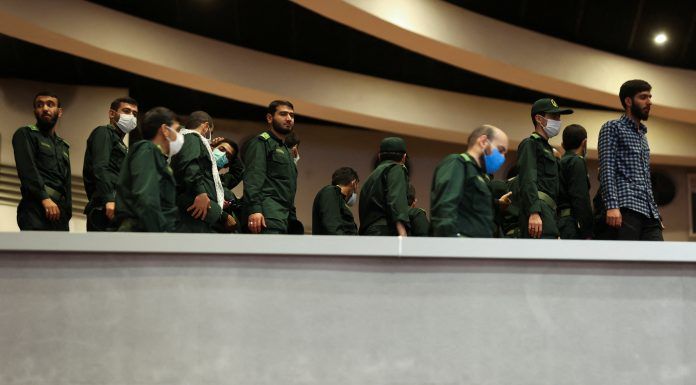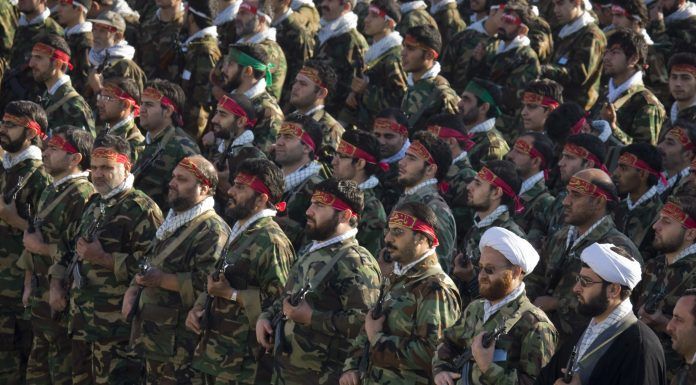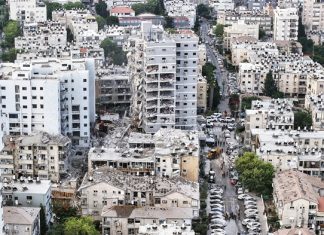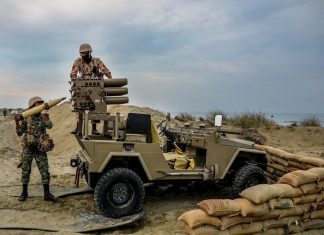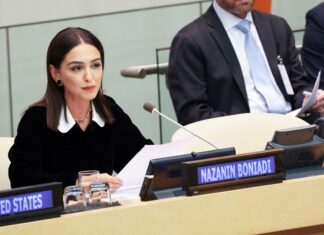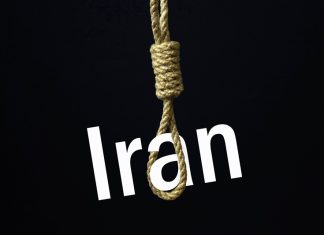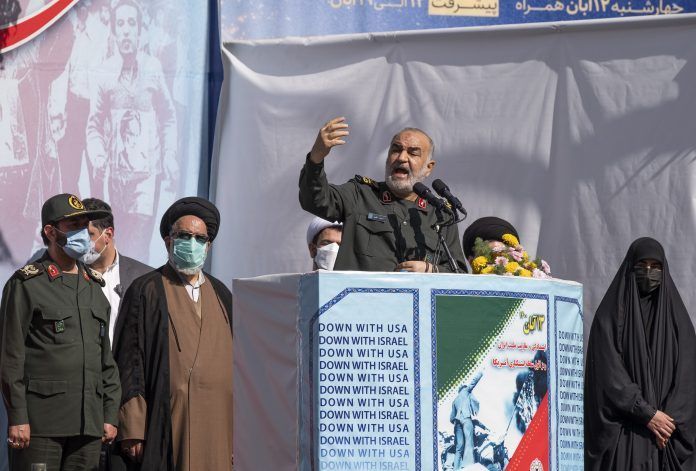
By Ahmad Rafat
In the past few weeks, there have been intense discussions on whether the U.S. should remove the Islamic Revolutionary Guards Corps (IRGC) from its list of Foreign Terrorist Organizations (FTO) in the past few weeks.
Former U.S. President Donald Trump’s administration added the IRGC to its FTO list in 2019.
Iran has said progress is impossible in the ongoing talks in Vienna on reviving the 2015 Iran Nuclear Deal — the Joint Comprehensive Plan of Action (JCPOA) — until the U.S. lifts all sanctions on the IRGC and removes the group from its FTO list.
Meanwhile, U.S. President Joe Biden and the Chair of the Joint Chiefs of Staff (CJCS), General Mark Milley, have said the Qods Force (QF) should remain on the U.S. list of FTOs.
President Biden and General Milley’s comments suggest that the IRGC and the QF —which are responsible for the IRGC’s extraterritorial operations — are two separate entities. However, nothing could be further from the truth, because the two forces are part of the same entity.
The Qods or Quds (Arabic name for Jerusalem) Force’s name derives from the Islamic Republic’s military aim to conquer Jerusalem. It was created under Article 7 of the IRGC’s charter, which calls for supporting Islamic movements outside Iran.
The precursor to the QF was the “Liberation Movements Units” headed by Abbas Mohammad Montazeri (1944-1981), a son of Grand Ayatollah Hussein-Ali Montazeri (1922-2009), once the designated successor of the founder of the Islamic Republic Ayatollah Ruhollah Khomeini before the two men fell out in 1989 over government policies.
The Liberation Movements Units operated under the IRGC’s auspices.
Abbas Mohammad Montazeri died in a bomb attack on the Islamic Republic Party’s central headquarters in Tehran on June 28, 1981. After Montazeri’s death, Mehdi Hashemi, the brother of Ayatollah Hussein-Ali Montazeri’s son-in-law, took over the Liberation Movements Units until 1982, when the group was dissolved.
The IRGC’s Intelligence Organization had direct supervision over the Islamic Liberation Movements Units for a while.
Ayatollah Ali Khamenei succeeded Ayatollah Ruhollah Khomeini after his death on June 3, 1989, becoming Iran’s Supreme Leader and the commander-in-chief of the Islamic Republic’s armed forces.
Two years after the Iran-Iraq War (1980-88), Mr. Khamenei ordered the formation of the Qods Force as the IRGC’s fifth military arm. The others were the IRGC’s Ground Forces, Aerospace Force, Navy, and the Basij (volunteer forces).
SPECIAL REPORT- Iran’s Leader Ordered Crackdown on Unrest: “Do Whatever It Takes to End It”
IRGC Officer Tells Tribunal of Khamenei’s Alleged Role in Suppressing 2019 Protests
The Qods Force is not an independent military force, but rather an integral part of the IRGC.
U.S. officials have offered no explanation for making a distinction between the Qods Force and the IRGC. The two are inseparable and inextricably linked. Some American sources have tried to justify the distinction by highlighting the IRGC’s domestic activities and the Qods Force’s extraterritorial operations, which is a distinction without a difference.
The Qods Force does not hide its military support for regional militia groups, including Lebanese Hezbollah, Yemen’s Houthi rebels (Ansar Allah), Palestinian Hamas, Palestinian Islamic Jihad Movement (PIJ) in Gaza, and the Iraqi Popular Mobilization Forces (PMF).
The PMF, also known as the People’s Mobilization Committee (PMC) and the Popular Mobilization Units (PMU), is an Iraqi state-sponsored umbrella organization composed of some 40 militias, mostly Shia Muslim but also including Sunni Muslim, Christian, and Yazidi groups.
The Qods Force supplies these groups with missiles, drones, and other military equipment manufactured by domestic industries close to the IRGC and Iranian Defense Ministry.
Contradictory comments by senior U.S. officials reveal a lack of cohesive policy on the subject.
In an interview with the U.S. TV network NBC, U.S. Secretary of State Antony Blinken said the IRGC “was a terrorist organization.” However, he did not give a clear answer when asked by the same reporter if that “terrorist organization” should remain on the list of sanctioned entities.
Iranian lobby groups in the U.S. have been trying hard to remove the IRGC from the FTO list. However, it is highly unlikely that the U.S. would decide on the matter until after the November 2022 mid-term elections.
All 435 members of the House of Representatives and 35 of the 100 senators will fight for their seats in the November 2022 mid-term elections. Whether to remove the IRGC from the FTO could impact the U.S. elections results.
While including the IRGC in the FTO list resulted from the group’s support of the Syrian government, Lebanese Hezbollah, and Yemeni Houthi rebels, designating the Qods Force as a foreign terrorist organization resulted from its military operations in Iraq and killing of 600 members of the U.S. military in that country.
In an article published in the April 5 edition of The National Interest (TNI), a bimonthly conservative international relations magazine, Ryan Costello, the policy director of the National Iranian American Council (NIAC), wrote about removing the IRGC from the FTO list.
“The main issue at hand is the Foreign Terrorist Organization (FTO) designation of the Islamic Revolutionary Guard Corps (IRGC), which was enacted by the Trump administration in April 2019 and which Iran has demanded be removed in any nuclear deal,” Mr. Costello said. “It would be difficult, if not impossible, for any Iranian political leader to sign off on a deal that leaves the IRGC in the same category as non-state actors like Al Qaeda and ISIS.”
“The Biden administration has appeared to waffle on its willingness to rescind the designation while pushing for non-nuclear de-escalatory concessions in exchange for the delisting, with no visible progress for several weeks,” Costello added. “As such, a stalemate has set in, with the Biden administration appearing to fear the political costs of reaching the finish line.”
In an article published in the April 4 issue of The Middle East Eye, Seyyed Hossein Mousavian, a member of the former Iranian President Hassan Rouhani’s nuclear negotiating team with the European Union (EU) and the UN International Atomic Energy Agency (IAEA), argued that it would be in the U.S.’s interest to remove the IRGC from the FTO list.
“There are two relevant considerations here. Without the IRGC’s participation, there can be no agreement with Iran on regional crises,” Mr. Mousavian, a visiting research scholar at Princeton University, said. “This is an argument for the Biden government to delist the IRGC to facilitate bilateral dialogue on regional issues.”
It is not surprising that Biden’s government, whose secretary of state has called the IRGC a “terrorist organization,” might remove the group from the FTO list. President Biden removed Houthi rebels, who launched drone attacks on civilian targets in Saudi Arabia and the United Arab Emirates (UAE), from its FTO list-a decision that strained U.S. relations with both Arab countries.
There have been calls for removing the IRGC’s Ground Forces commander, Brigadier General Mohammad Pakpour, from the list of senior IRGC officials under U.S. sanction. However, general Pakpour recently said: “Even if all senior American officials were to be killed, it would not be enough to avenge the blood of Ghasem Soleimani,” adding that “revenge will continue through other means.”
The late Lieutenant General Ghasem Soleimani, former commander of the IRGC-QF, was killed in a U.S. drone attack on the Baghdad International Airport on Jan. 3, 2020.
Speaking to reporters a few days later, Edward “Ned” Price, the spokesperson for the U.S. State Department, said the IRGC and the Qods Force were to remain on the FTO list for the time being. Mr. Price did not comment on whether the IRGC could be removed from the list.
U.S. officials’ refusal to answer reporters’ probing questions about the issue only strengthens speculations that discussions with Tehran on removing the IRGC from the FTO list are serious, and despite the current pause, the negotiations in Vienna to revive the JCPOA continue.
Separating the IRGC and the Qods Force is a distinction without a difference and has no logical merits. It is not the same rationale some countries used to recognize the political wing of Hezbollah while sanctioning its military arm. Hezbollah’s political wing includes groups that are not armed.
[aesop_image img=”https://kayhanlife.com/wp-content/uploads/2020/02/2020-01-09T000000Z_642566432_MT1ABCPR715274017_RTRMADP_3_ABACA-PRESS-scaled.jpg” panorama=”off” credit=”REUTERS./” align=”center” lightbox=”on” captionsrc=”custom” caption=”FILE PHOTO: Ali Khamenei (R) greeting commander of the Quds Force of the Islamic Revolutionary Guard Corps Esmail Qaani (L), Iranian Armed Forces Chief of Staff Major General Mohammad Bagheri (C), and Iranian Islamic Revolutionary Guard Corps (IRGC) Chief Commander Hossein Salami, during a mourning ceremony in Tehran for Qasem Soleimani, Tehran, Iran on January 9, 2020. ” captionposition=”left” revealfx=”off” overlay_revealfx=”off”]
[aesop_image img=”https://kayhanlife.com/wp-content/uploads/2020/09/2010-02-09T120000Z_235817299_GM1E62A010W01_RTRMADP_3_IRAN-ITALY-ATTACK-scaled.jpg” panorama=”off” credit=”REUTERS./ ” align=”center” lightbox=”on” captionsrc=”custom” caption=”FILE PHOTO: Basij militia (IRGC). ” captionposition=”left” revealfx=”off” overlay_revealfx=”off”]
The IRGC and the Qods Force are armed groups and operate under the same command. Both organizations have military objectives and are banned from political activities under the IRGC charter.
The Islamic Republic considers the IRGC and the Qods Force an integral part of its armed forces. Tehran argues that the U.S. cannot designate a country’s official military force as a terrorist organization.
There have been dozens of reports published in recent years by government and non-government institutions that have identified the IRGC as a sponsor of terrorism in the region and as a principal element of the international terror network.
The terrorist attack (two truck bombs) on a barrack in Beirut, Lebanon, housing American and French service members on October 23. 1983, resulting in the death of 305 people (241 U.S. and 58 French military personnel and six civilians, and two attackers), was an example of a terrorist act allegedly sponsored by the IRGC.
According to some documents presented in a U.S. court, the suicide attacks were allegedly carried out by Hezbollah at the behest of the IRGC. The IRGC had not created the Qods Force at the time. The IRGC reportedly expanded its extraterritorial terrorist operations after creating the Qods Force.
While many U.S. senior military officials, lawmakers, and analysts argue the IRGC should remain on the FTO list, some high-profile figures in Iran also believe that the best way to curb the power and influence of the force is by keeping the sanctions on the group in place.
Faezeh Hashemi-Rafsanjani, the daughter of the late Iranian President Akbar Hashemi-Rafsanjani (who was in office from 1989 to 1997), said she didn’t consider removing the IRGC from the list of entities under sanction would be “in [Iran’s] national interest.” She said keeping the sanctions was “the only way to return the IRGC to its barracks.”
A reporter from the Fars news agency, which has strong ties to the IRGC, commented that Ms. Hashemi’s remarks “warranted a security probe,” adding that “she acted as a foot soldier for the U.S. inside Iran.”

